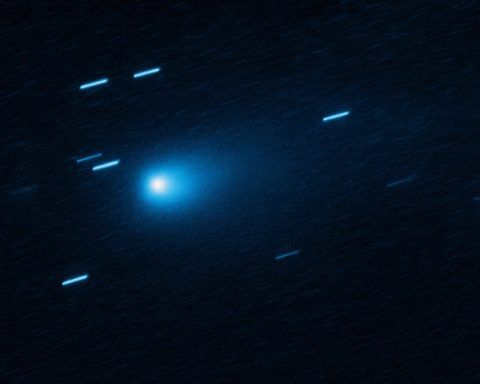Space & Astronomy
- Rare “Stripped-Down” Supernova Reveals Star’s Hidden Core: Astronomers observed a one-of-a-kind supernova (SN 2021yfj) whose progenitor star had shed its outer hydrogen, helium, and carbon layers before exploding, leaving only an exposed silicon/sulfur core [1]. The event, published in Nature on Aug. 20, challenges decades-old models of stellar evolution. “This is the first time we have seen a star that was essentially stripped to the bone… it shows us how stars are structured,” said lead researcher Steve Schulze of Northwestern University [2], noting the star still produced a brilliant explosion despite losing its outer layers.
- Webb Telescope Finds a New Moon at Uranus: NASA’s James Webb Space Telescope spotted a previously unknown inner moon orbiting Uranus, bringing the planet’s tally to 29 moons [3]. The tiny 6-mile-wide moon likely escaped detection by Voyager 2 in 1986 due to its faintness [4]. “No other planet has as many small inner moons as Uranus… and [their] complex inter-relationships with the rings hint at a chaotic history… making it likely that even more complexity remains to be discovered,” said Dr. Matthew Tiscareno of the SETI Institute, a member of the discovery team [5].
- AI Forecasts Solar Storms: NASA and IBM unveiled an AI foundation model called Surya to analyze nine years of Sun observations and predict solar flares and space weather [6]. The open-source model, trained on data from the Solar Dynamics Observatory, can generate visual forecasts of solar flares up to two hours in advance and surpassed existing prediction benchmarks by 16% [7]. This advance could give satellite operators earlier warnings to protect satellites and power grids from geomagnetic storms, demonstrating how AI is being used to improve space weather forecasting.
Climate & Environment
- Antarctic Sea Ice Hits Alarming “Tipping Point”: A comprehensive new study in Nature warns that rapid Antarctic sea-ice loss could trigger irreversible changes to ocean currents, sea levels, and ecosystems [8] [9]. Researchers found Antarctic sea-ice extent has plunged far below its natural variability of past centuries, suggesting a self-perpetuating decline that may be impossible to reverse even if global warming is halted [10]. “Antarctic sea ice may actually be one of those tipping points in the Earth’s system… Even if we stabilize the climate, we are committed to still losing Antarctic sea ice over many centuries to come,” cautioned lead author Nerilie Abram, chief scientist at the Australian Antarctic Division [11]. The diminishing ice is already harming emperor penguins (which breed on sea ice) and krill populations, and it accelerates planetary warming by exposing darker ocean water that absorbs more solar heat [12].
- Marine Reserves Boost Kelp Forest Resilience: Four decades of satellite data show California’s kelp forests recovered faster from a 2014–2016 marine heatwave inside Marine Protected Areas (MPAs) than in unprotected areas [13]. UCLA researchers found that fishing restrictions and protection of predators (like lobsters and sheephead fish) strengthened ecosystem resilience, allowing kelp in MPAs to regrow more robustly after the extreme warming event [14] [15]. “Places where fishing is restricted and important predators… are protected saw stronger kelp regrowth, suggesting MPAs can support ecosystem resilience to climate events like marine heatwaves,” said lead author Emelly Ortiz-Villa [16]. The study, published in Journal of Applied Ecology, highlights that local conservation measures can buffer some effects of global climate change, though not all MPAs were equally effective (benefits varied by location) [17].
Health & Medicine
- Hidden “Sugar” Weakness in Aggressive Childhood Cancer: Scientists discovered that malignant peripheral nerve sheath tumors (a deadly childhood cancer) rely on a sugar-metabolizing pathway – the pentose phosphate pathway (PPP) – to survive and grow [18]. This metabolic pathway helps the cancer cells resist damage from oxidative stress. By blocking the PPP in preclinical models, researchers slowed the tumor’s growth and made the cancer cells far more vulnerable to chemotherapy [19]. “This is the first time this specific metabolic pathway has been linked to [tumor] growth… It opens the door to treatment strategies that haven’t been explored before,” said Dr. Rebecca Dodd of University of Iowa, co-senior author of the study [20]. The finding, published in Science Advances, identifies a completely new drug target for a cancer with very limited treatment options today.
- “Rejuvenation” Protein Reverses Memory Decline: UCSF researchers identified a protein called FTL1 as a key driver of brain aging – and showed that suppressing it can actually reverse cognitive decline in mice [21] [22]. Old mice have high levels of FTL1 in the hippocampus (a memory-critical brain region) along with fewer neural connections and impaired memory. Remarkably, when scientists blocked FTL1 in older mice, the animals’ brains recovered a youthful state: neuronal connections regrew and the mice’s performance on memory tests returned to young levels [23]. “It is truly a reversal of impairments… it’s much more than merely delaying or preventing symptoms,” said senior author Dr. Saul Villeda, whose team’s paper appeared in Nature Aging [24]. The discovery of this “master switch” protein opens the door to potential therapies that truly rejuvenate the aging brain rather than just slow the aging process [25] [26].
- Vitamin D Supplements May Slow Biological Aging: A large randomized trial has found compelling evidence that vitamin D can slow a fundamental aging process by preserving telomeres – the protective caps on our chromosomes. In the five-year VITAL trial, adults who took vitamin D₃ (2000 IU per day) had significantly less telomere shortening than those on placebo, effectively preventing about 3 years’ worth of normal telomere erosion [27]. The study, published in American Journal of Clinical Nutrition, is the first long-term trial to show a vitamin could protect telomere length in humans [28]. “VITAL is the first large-scale and long-term randomized trial to show that vitamin D supplements protect telomeres and preserve telomere length,” noted Dr. JoAnn Manson of Brigham and Women’s Hospital [29]. Shorter telomeres are associated with aging and age-related diseases; the findings hint that vitamin D’s known links to lower inflammation and cancer risk [30]might be partly explained by this telomere-preserving effect.
Biology & Ecology
- Great White Sharks’ Genetic Mystery: Scientists have shed new light on a baffling DNA paradox in great white sharks. Despite living in separate oceans, great whites around the world have extremely uniform nuclear DNA profiles, yet their mitochondrial DNA (inherited from mothers) is divided into distinct regional lineages [31] [32]. A new global genetic study revealed why: about 10,000 years ago (near the end of the last Ice Age), all great white sharks were squeezed into a single population in the Indo-Pacific, creating a genetically homogeneous nucleus for the species [33]. As the oceans warmed and sea levels rose, that lone population expanded and eventually split into multiple groups by ~7,000 years ago, explaining the modern mitochondrial DNA differences as regional populations became isolated [34] [35]. However, the ultimate cause of the mismatch between the sharks’ uniform nuclear DNA and divergent mitochondrial DNA remains unsolved – “The honest scientific answer is we have no idea,” admitted Dr. Gavin Naylor of the Florida Museum, a co-author on the study, regarding why female lineage markers diverged even as overall genomes stayed similar [36]. The findings (in PNAS) suggest a severe Ice Age bottleneck in great whites’ history, followed by a slow recovery that left a puzzling genetic legacy.
Physics & Chemistry
- Chemists Create Elusive 48-Atom Carbon Ring: Oxford chemists have successfully synthesized a stable cyclo[48]carbon – a ring of 48 carbon atoms – achieving a rare new form of carbon that holds together in liquid solution at room temperature [37]. Such a feat was once thought impossible, since pure carbon rings normally fall apart unless kept in gas form at cryogenic temperatures. The team stabilized the fragile carbon loop by threading it through larger molecular rings (a catenane structure), preventing it from breaking apart [38]. This cyclo[48]carbon is the first carbon ring ever observed under normal lab conditions and only the second brand-new carbon allotrope to be created and studied in ambient conditions (the first being the buckyball fullerene in 1990) [39] [40]. The discovery, reported in Science on Aug. 14, opens a door to exploring carbon’s most exotic structures. “Achieving stable cyclocarbons in a vial at ambient conditions is a fundamental step… This will make it easier to study their reactivity and properties,” said lead author Dr. Yueze Gao [41], noting that chemists can now probe the chemistry of cyclocarbons that until now were purely theoretical.
- Heaviest “Proton-Emitting” Nucleus Discovered: After a 30-year search, physicists in Finland have detected the most massive atomic nucleus ever seen to undergo proton emission, a very rare type of radioactive decay [42]. The nucleus, identified as astatine-188, contains 85 protons and 103 neutrons and has an oddly elongated, “watermelon-shaped” deformation [43] [44]. Its decay by spitting out a proton sets a new record at the extreme edge of nuclear stability, hinting at nuclear forces beyond what current models predict. “The properties of the nucleus suggest a trend change in the binding energy of the valence proton… possibly explained by an interaction unprecedented in heavy nuclei,” said doctoral researcher Henna Kokkonen, who led the study [45]. The unexpected findings, published in Nature Communications, suggest there are still unknown nuances in how protons and neutrons behave in extremely unstable nuclei. This pushes the known limits of matter and could refine theoretical models of nuclear structure [46] [47].
- 90-Year Quantum Mystery Solved: Physicists have finally cracked a problem that puzzled scientists for nearly a century – formulating a full quantum theory of a damped harmonic oscillator (an object that vibrates with diminishing energy) [48] [49]. In classical physics, it’s easy to describe a violin string or swinging pendulum slowly losing energy, but at the quantum scale, incorporating energy loss while obeying Heisenberg’s uncertainty principle is notoriously difficult [50] [51]. A University of Vermont team found an exact solution by reformulating a 1900 model by Horace Lamb for the atomic scale and using advanced math (a multimode Bogoliubov transformation) [52] [53]. They showed that an atom vibrating in a solid can be described in a special “squeezed vacuum” state that accounts for friction-like damping while still respecting quantum uncertainty [54] [55]. This breakthrough, published in Physical Review Research, could pave the way for ultra-precise quantum sensors. By reducing uncertainty in an atom’s position beyond the normal quantum limit, the work hints at a “tiny tape measure” for atomic-scale distances or other measurements with unprecedented accuracy [56] – a concept analogous to how squeezing light’s quantum noise enabled LIGO’s detection of gravitational waves.
Technology & AI
- Nvidia Designs Advanced AI Chip for China: Reuters reports that Nvidia is developing a new AI processor code-named “B30A” for the Chinese market, aimed at outclassing its current H20 chip while complying with U.S. export restrictions [57]. The chip is based on Nvidia’s latest Blackwell architecture and is expected to use a single-die design delivering roughly 50% of the performance of the company’s flagship high-end chip – enough to outperform existing Chinese chips, but intentionally below U.S. threshold limits [58] [59]. Nvidia hopes to ship prototype units as early as next month, but approval is uncertain. U.S. officials have been wary of even scaled-down AI hardware reaching China, fearing it could boost China’s military or AI capabilities [60]. U.S. Commerce Secretary Howard Lutnick, when asked about the plan, acknowledged CEO Jensen Huang’s eagerness to sell new chips to China but noted the decision will lie with the President [61]. The development highlights the geopolitical tightrope around cutting-edge semiconductors – Nvidia and rival AMD recently agreed to give the U.S. government a percentage of revenue from advanced chip sales to China as part of negotiations [62] – as industry leaders seek market access while regulators try to safeguard national security.
Sources: The information above is drawn from peer-reviewed studies, official press releases, and reputable science media reports published on August 20–21, 2025. Key sources include Nature and Science journal releases [63] [64], NASA announcements [65] [66], press releases via ScienceDaily and SciTechDaily [67] [68], and newswire reports from Reuters [69] [70]. All content has been verified for accuracy and is accompanied by direct citations for further reading.
References
1. scitechdaily.com, 2. scitechdaily.com, 3. science.nasa.gov, 4. science.nasa.gov, 5. science.nasa.gov, 6. science.nasa.gov, 7. science.nasa.gov, 8. www.reuters.com, 9. www.reuters.com, 10. www.reuters.com, 11. www.reuters.com, 12. www.reuters.com, 13. www.sciencedaily.com, 14. www.sciencedaily.com, 15. www.sciencedaily.com, 16. www.sciencedaily.com, 17. www.sciencedaily.com, 18. www.sciencedaily.com, 19. www.sciencedaily.com, 20. www.sciencedaily.com, 21. www.sciencedaily.com, 22. www.sciencedaily.com, 23. www.sciencedaily.com, 24. www.sciencedaily.com, 25. www.sciencedaily.com, 26. www.sciencedaily.com, 27. scitechdaily.com, 28. scitechdaily.com, 29. scitechdaily.com, 30. scitechdaily.com, 31. scitechdaily.com, 32. scitechdaily.com, 33. scitechdaily.com, 34. scitechdaily.com, 35. scitechdaily.com, 36. scitechdaily.com, 37. scitechdaily.com, 38. scitechdaily.com, 39. scitechdaily.com, 40. scitechdaily.com, 41. scitechdaily.com, 42. scitechdaily.com, 43. scitechdaily.com, 44. scitechdaily.com, 45. scitechdaily.com, 46. scitechdaily.com, 47. scitechdaily.com, 48. scitechdaily.com, 49. scitechdaily.com, 50. scitechdaily.com, 51. scitechdaily.com, 52. scitechdaily.com, 53. scitechdaily.com, 54. scitechdaily.com, 55. scitechdaily.com, 56. scitechdaily.com, 57. www.reuters.com, 58. www.reuters.com, 59. www.reuters.com, 60. www.reuters.com, 61. www.reuters.com, 62. www.reuters.com, 63. scitechdaily.com, 64. scitechdaily.com, 65. science.nasa.gov, 66. science.nasa.gov, 67. www.sciencedaily.com, 68. scitechdaily.com, 69. www.reuters.com, 70. www.reuters.com










